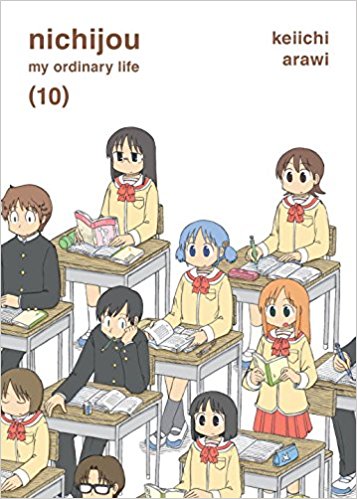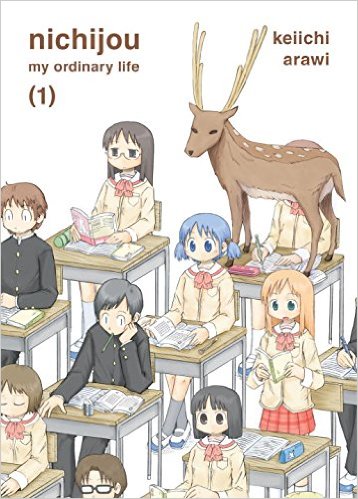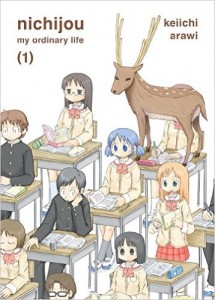By Keiichi Arawi. Released in Japan by Kadokawa Shoten, serialized in the magazine Shonen Ace. Released in North America by Vertical Comics. Translated by Jenny McKeon.
I haven’t reviewed Nichijou in full since its first volume, it not being the sort of series that lends itself to deep discussion. This is the final volume, though, and I think that it’s worth looking at to see how far the series has come and how abstract it is now. The creator almost seems to be hiding it with the final cover, which features the cast in class paying attention stoically, but it’s meant to contrast with the first volume, which had a random deer on Yukko’s desk. The cast does still feature, and there is, believe it or not, character development of a sort, particularly in the ‘flashforward’ chapters, but for the most part Arawi has honed his surrealist art skills here, and knows what his audience wants: randomness and reaction shots from Mio. We get those in abundance in this volume.
Let’s look at that character development. Some of it can be seen at the start, where Mai and Yukko team up to prank Mio over and over again in a game of musical chairs. But then this is followed by a chapter, seemingly set moments later, which features Yukko rapping for pages on end and embarrassing her friends. Nichijou is not a title you want to read if you get frustrated by randomness – it never stays in one place too lo0ng, it’s quite happy to toss aside reality when it wants to, and in the ‘short panel collection’, sometimes the stories are only a panel or two long. The flashforwards, however, are a bit more developed. We saw one of them in the prior volume, showing a Professor who’s actually attending school, and Yukko apparently returning from America. Here we see more, as we have Mio as an actual manga artist, with an overworked assistant, begging for last-minute help from Mai, who now teaches preschool. This is mostly fascinating because of Mai, who has always been the quiet stoic “troll”. She’s still quiet here, but seeing her smiling and showing genuine emotions is both startling and heartwarming.
In the ads afterwords, Vertical mentions Helvetica Standard, the two-volume series coming out in the fall that’s connected to Nichijou (it’s the manga Yuna is reading all the time), but it’s apparently more of an artbook with occasional comics and diaries. The “successor” to Nichijou is Arawi’s current work City, which Vertical has also licensed. What these licenses tell me, besides the fact that Nichijou must have sold better than I expected, is that it’s Arawi’s art that seems to be the big pull. There are some startling frames in this volume, particularly in the aforementioned “Mio reaction shots”, where he really goes the extra mile in making things weird yet fascinating. In the end, Nichijou oddly reminds me of Short Cuts, the old manga series by Usamaru that Viz released back in the day. The characters are fascinating, and we like them, but in the end you tend to read Nichijou for the art and the really, really weird humor. It’s been an experience.



